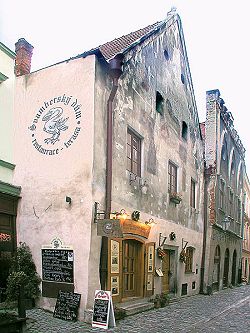Soukenická No. 35
Description of the Building:
A one-storey house with three window axis and a pointed gable, the
facade is not plastically molded; in the entrance hall is barrel
vaulting with shallow ribs, on the left is a single-flight
staircase leading to the first floor.
Architectural and Historical Development:
The house is of medieval origin and the cellars probably come from
that time. There was an underground access to the building on the
opposite side of the road and also to the yard. We cannot exclude
the medieval origin of the vaulting in the left section on the
ground floor. The entrance hall with a simple portal was
reconstructed in the late Rennaissance period. The rear part of the
ground floor and the top floor were newly renovated in the
1960s.
Significant Architectural Features:
The most valuable elements of the entire building are wall
decorations on the facade that originate from the late-Middle Ages
- it is the largest extent of such decorations of all the houses in
Český Krumlov. On the gable are coats of arms decorated with the
Rosenberg rose, a horse and a duck. On the first floor there is a
mural of St Florian building the town, an unknown saint with a
mitre, an unknown figure and an unknown symbol. We can also mention
stone vaults in cellars and a simply profiled rectangular
Rennaissance portal.
History of the House Residents:
Mates Platner, who was later followed by Baltazar Stadelbauer, was
the first known owner of the house in 1582. From 1590 the house
belonged to a butcher Mertl and three years later to Václav Pankl.
The Hartingers inherited the house and they owned it until 1633
when Martin Schisslkorb moved there. He is mentioned as the owner
of the house even in the second half of the 17th century. In 1687
the house was bought by Jan Petit. He owed 58 Rhenish guldens to
the municipality and that is why he offered his cellar to serve the
town´s brewery. In the years 1706 - 1769 the carpenter´s trade,
which had successors in the family of Adalbert Holzinger, was
carried out in the house. Josef Scheib moved there until the end of
the 18th century, followed by Jan Stöger in 1790 and in the first
half of the 19th century the family of Jan Zettle, followed by
František and Františka Justl after 1840.
Present Use:
Restaurant
Švamberk house



